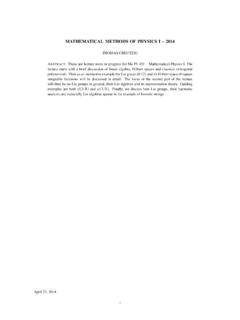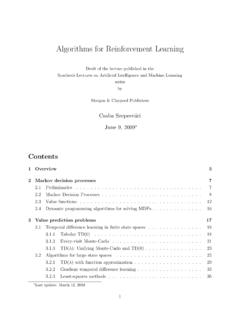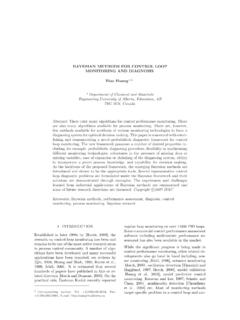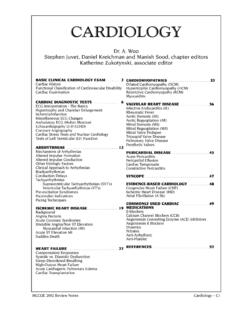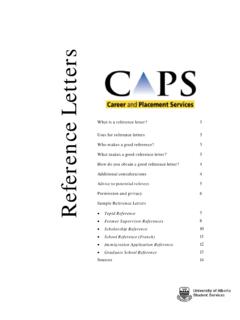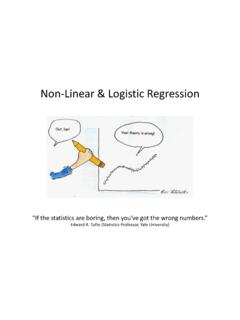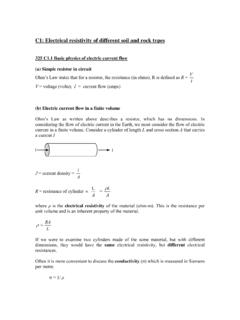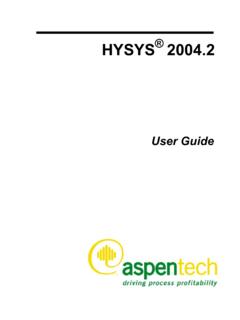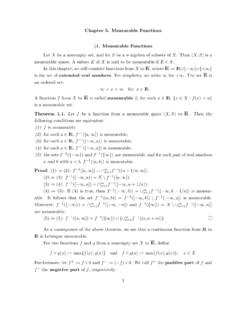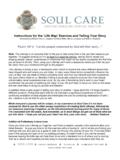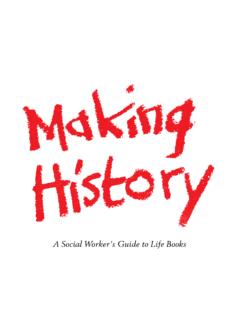Transcription of My Story, my life, my identity - University of Alberta
1 International Journal of Qualitative Methods 3 (4) December 2004My story , my life , my identityJulia ChaitinJulia Chaitin, PhD, Assistant Professor, Department of Conflict Analysis and Resolution,Graduate School of Humanities and Social Sciences, Nova Southeastern University , FortLauderdale, FloridaAbstract: In this article, the author looks at the use of the methods of life stories or biographicalinterviewing in research on personal and social identity . She presents the rationale behind theuse of the method and its basic procedures and then moves on to a discussion of the concept ofidentity. To demonstrate the relevance of this method for the study of identity construction, shepresents examples from three life story interviews with Jewish Israeli young adults, all born inthe mid 1970s. The article ends with a discussion of the implications of using life stories forunderstanding an individual s sense of : life story , biography, identityCitation information:Chaitin, J. (2004).
2 my story , my life , my identity . International Journal of Qualitative Methods,3(4), Article 1. Retrieved INSERT DATE from ~iiqm/backissues/3_4/ my story , MY life , MY IDENTITYI nternational Journal of Qualitative Methods 3 (4) December 20042 IntroductionIn this article, I focus on using the life story method for exploring the expression of personal andcollective identities. To gain a deeper understanding of how the life story method and the conceptof identity can tie together, I will present examples of how identities are expressed in the lifestory interviews of three Jewish Israelis born in the early 1970s, around the time of the YomKippur War (1973).I chose to study this method and to demonstrate its use for understanding this cohort for tworeasons one more academic and one more personal. For academic reasons, I believe it isworthwhile to explore the use of life stories in the study of issues of identity , as the two areas caninform and enhance one another. By bringing the two areas together, we will not only learnsensitive approaches to the study of identity but also, I hope, learn more about aspects of are a number of reasons for choosing the population that I did, and they are detailed and personal reasons for choice of cohort Jewish Israeli young adultsI have chosen to look at the identity of Jewish Israeli young adults who were born after the Israelioccupation of the West Bank and the Gaza Strip (in 1967), because this cohort grew up in anIsrael that not only differed significantly from that of their parents generation but also differedfrom the commonly held perception of Israel, held by those of us living in the Diaspora (Chaitin,2004).
3 As opposed to their elders, the occupation of the Palestinian people, and the conflict thathas ensued because of the continued occupation, has always been part of the normal social andpolitical reality for these young social reality of these young adults is also connected to the fact that since the decade of theirbirth, Israeli society has been characterized by increased Westernization and has moved awayfrom an emphasis on Zionist, socialistic, and communal needs and identity which characterizedthe Yishuv (Jewish prestate Israel) and the early years of statehood (Eisenstadt, 1973; Sachar,1996; Segev, 1998; Zerubavel, 2002) to an emphasis on individual needs, aspirations, anddevelopment. Pre-1970 Israel manifestly proclaimed the value of socialistic and communal waysof life over capitalistic and individualistic lifestyles. During the first 25 years of statehood, Israelwas busy with the establishment of its infrastructures, engaged in a number of wars with her Arabneighbors, and also taken up with absorbing and settling massive numbers of Jewish immigrantsfrom around the world (Bickerton & Klauser, 2002).
4 It is safe to assume that these nationalmissions could be accomplished only through strong social support and reinforcement ofcommon, supraordinate goals above individual Israeli young adults have been the topic of prior research studies, albeit mostly fromcohorts born before the years under discussion in this article. Published research has centered onthe place of the Holocaust in young adult lives ( , Bar-On, 1995; Chaitin, 2004; Feldman,2002), the connection between military service and issues such as the Arab/Palestinian/Israeliconflict and gender identities ( , Helman, 1999; Linn, 1986, 1996; Lomsky-Feder, 2004;Lomsky-Feder & Ben-Ari, 1999; Sasson-Levy, 2003); the impact of the assassination of YitzchakRabin on young people (Shapira, 2000 ), and the place of the Sabra identity in the construction ofJewish Israeli identity (Almog, 2000; Moore & Bar-On, 1996). In the section below on theconcept of identity , I will take a closer look at the concept of the Sabra and its connection to thedevelopment of Jewish Israeli my story , MY life , MY IDENTITYI nternational Journal of Qualitative Methods 3 (4) December 20043As noted above, my interest in exploring Jewish Israeli young adults is not only academic butalso personal.
5 After emigrating from the United States to Israel in 1972, I settled on a of my children were born in the mid 1970s, and many of my close friends children wereborn during these years as well. For 10 years, I worked as a mitapelet (a child caretaker) in thekibbutz s informal educational system. Therefore, this is an age cohort that I know , for a number of years, I was an instructor at Ben-Gurion University , and as a result,I had a great deal of contact with Jewish Israelis born during these years. In one sense, then, theseare my children. I have always been fascinated with their perception of Israeli society andculture, and their sense of identity within this will now move on to a presentation of the rationale and method of life story /biographicalresearch. Then, I will look at various perspectives of the concept of identity . After discussingconnections between the life story method of interviewing and the concept of identity , I willpresent excerpts from three interviews with Jewish Israeli young adults that demonstrate how lifestories can shed light on the perception of one s identity .
6 I will end the article with a discussion ofthe implications of using life story interviews for understanding an individual s sense of story interviewingI would like to begin with the explanation and rationale for using life story , or biographicalinterviewing,2 a method first introduced by the German sociologist Schutze (1983, 1984) whenattempting to understand the meanings that individuals give to their lives and the socialphenomena that they have experienced. As researchers in different disciplines and geographicalareas have shown, the life story method can be an extremely sensitive method foraccomplishment of this goal ( , Lieblich, Tuval-Mashiach, & Zilber, 1998; Lomsky-Feder,2004; Rosenthal, 1993, 1998, 2004; Wengraf, 2001). The life story method is classified as onetype of phenomenological approach to research (van Manen, 1996, 2002); that is, it focuses onthe understandings and significance that people give to their life experiences. When doingphenomenological research, the researcher wishes to learn what the individual has lived through,how and where the experiences that the person has had figures into their lives, and how he or sheunderstands life in light of those major underlying assumption of the biographical mode of interviewing is that eachindividual has a unique story to tell and a unique understanding of that experience.
7 Therefore, toget at that experience, we must find ways that allow the individual to tell us about his or her lifeexperiences in as full and open a way as possible that allows this uniqueness to find our theoretical/conceptual frameworks on the individual during the interview processwill hinder this process (Rosenthal, 1993).A second, complementary underlying assumption of the biographical method of interviewing isthat although the life story of each biographer is unique, the stories are also embedded inparticular social and cultural contexts. Therefore, by studying these stories, we gain not onlyunderstandings of the individual and his or her experiences but also insights into the particularsocial structures and dynamics and cultural values, mores, and norms in which the individuallives (Rosenthal 1993, 1998). A third assumption of this method is that people do not speak inrandom, unconnected sentences; when they relate their life story , they are choosing what to sayand how to say it.
8 Therefore, the life story can be interpreted and analyzed my story , MY life , MY IDENTITYI nternational Journal of Qualitative Methods 3 (4) December 20044In sum, then, the life story method of interviewing and analysis assumes that to understand themeaning that people give to their life experiences, we must have a way of eliciting stories abouttheir life experiences and then uncover these personal and social/cultural meanings throughsystematic interpretations of these interviewing: The basic procedureLife story interviewing is an extremely open-ended method of eliciting information from aresearch participant. At the beginning of the interview, after explaining the overall purpose of thestudy and obtaining the person s consent to participate in the study, the researcher asks theinterviewee termed the autobiographer a variant of the following question: Please tell meyour life story , whatever you think is relevant. The interviewer then sits quietly and does notdisturb the interviewee s narrative whatsoever until he or she has come to the end of his or herlife story (usually signified by a remark such as, That s it.)
9 That s my story . Do you have anyother questions? ) If the autobiographer has difficulty in getting going and asks the interviewer toprovide some guidance, the researcher is trained to reply with a statement such as, Talk aboutwhatever you think is important the choice is yours. The idea here is to not lead theautobiographers in any way but to allow them to choose freely how and what to talk story interviews can range from 10 minutes to many hours ( , Bar-On, 1995; Chaitin,2003; Chaitin & Bar-On, 2001; Rosenthal, 1993), depending on the interviewee and thesituational context and types of field constraints. As a rule, after the autobiographer has finishedrelating his or her story , the researcher will then ask intrinsic questions that is, questions thatarise from the interview ( , You noted that your high school years were happy ones. Couldyou please tell me a happy story from that period in your life ? ). These help the researcher fleshout details that he or she might feel are missing to get a good sense of the person.
10 In some cases,the interviewee also prepares extrinsic questions: questions that are of particular interest to him orher for the study. For example, in my research on the long-term effects of the Holocaust on thedescendants of survivors, I would often ask the grandchildren of survivors if they knew what theirgrandparent had lived through during the war, if the individual did not mention it beforehand(Chaitin, 2003, 2004).The biographical interview is tape-recorded, either by audio or visual means, so that theresearcher can undertake an in-depth interpretation of the material. A word-for-word transcriptionis made of the interview, and it is from this text that the researcher searches to connect theexperiences that the autobiographer has shared and the meanings that he or she gives to them. Theresearcher does not, however, need to look only for psychological impacts but might also analyzethe data for other impacts, such as cultural, sociological, historical, and educational (Chaitin,2002).
